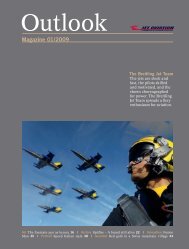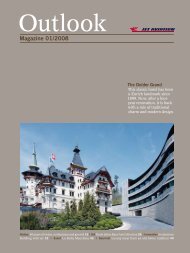profession: pilot career: actor - Jet Aviation
profession: pilot career: actor - Jet Aviation
profession: pilot career: actor - Jet Aviation
You also want an ePaper? Increase the reach of your titles
YUMPU automatically turns print PDFs into web optimized ePapers that Google loves.
Ricola makes about 25 different herbal<br />
products, which it exports to over 50<br />
countries. The original Ricola candy has<br />
13 herbs and was developed by Emil<br />
Richterich, a pastry chef in the small<br />
town of Laufen, Switzerland. When<br />
Richterich’s son Hanspeter was born in<br />
1930, it was clear that the profits from<br />
the bakery were not enough to support<br />
a family, so Richterich began to make<br />
candy. The new business was not<br />
successful during the time before the<br />
Second World War, but when food was<br />
rationed during the war, people began<br />
to buy the brown cubes so that they<br />
would not have to use their food coupons<br />
for sugar. In the early 1960s, the company<br />
decided to focus exclusively on<br />
two of its sweets, one of which was<br />
the herbal candy. Emil and Hanspeter<br />
cycled from store to store with a case of<br />
their samples, and the product was well<br />
received. In 1967 the company built a<br />
new f<strong>actor</strong>y exclusively for the production<br />
of herbal candies.<br />
Today, every single herbal candy still<br />
comes from Laufen. The town is a<br />
former Roman settlement that achieved<br />
city status in 1295. It now has just over<br />
5000 people, and 300 of them work<br />
for Ricola, making the company the<br />
second-largest employer in town. All<br />
shares in Ricola belong to the Richterich<br />
family, and Felix Richterich, grandson of<br />
the founder, is chairman of the board.<br />
Gaining popularity<br />
The original candies are brown and square<br />
– sort of chunky, more or less cubes with<br />
wavy lines on top. They do not all have the<br />
same shape. “The candies were square<br />
because the others at the time were round,”<br />
says Ricola CEO Adrian Kohler. “And also<br />
because this was an easy shape for the<br />
machines.”<br />
The candies became a part of life in<br />
Switzerland. Many Swiss remember being<br />
given Ricola by their grandmother. She<br />
would pull a candy with the yellow Ricola<br />
wrapper from her purse, or go to the<br />
cupboard and get the yellow tin<br />
containing a loose jumble of the brown<br />
cubes. The taste of Ricola was familiar<br />
and comforting.<br />
It did not take long for the sweets to<br />
catch on in other countries as well. After<br />
the Second World War, Italians came<br />
to Switzerland to buy gasoline, and on<br />
the same trip they picked up cigarettes,<br />
Knorr bouillon cubes, and Ricola candies.<br />
Responding to the interest, Ricola began<br />
to export to Italy.<br />
When Ricola tried to establish contacts<br />
to export to Germany in the 1960s, Richterich<br />
was told that the awkwardly shaped<br />
sweets were not marketable. Eventually<br />
a Swiss man, who headed a German<br />
company, felt sorry for Ricola and said he<br />
would try to sell 100,000 packages in a<br />
year. The packages sold in one month,<br />
Blending 13 herbs<br />
for the original<br />
candy<br />
Outlook 02/2008<br />
45







